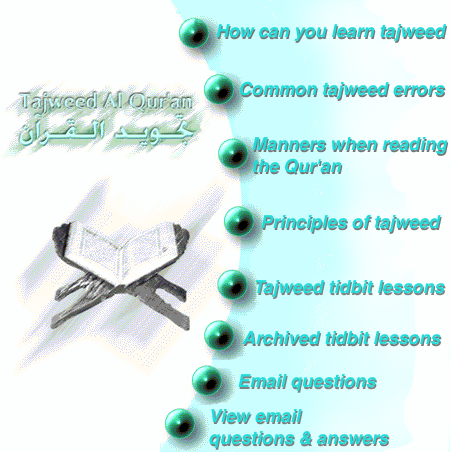Hamzah
Al-Wasl

Lesson
one
Introduction
It
is established that the reader of the Qur’an must start reciting with a
voweled letter, never a sukoon. It
is also an established fundamental of reading the Qur’an that stopping is
always with a sukoon on the last letter that is recited, never a vowel, except
with a way of stopping called
 which
will be discussed, Allah willing, later.
Some words are not written with a vowel on the first letter, and, as
stated starting a word with a sukoon is not allowed.
In this case an extra
hamzah is put on the beginning of the word.
This is called hamzah al-wasl,
which
will be discussed, Allah willing, later.
Some words are not written with a vowel on the first letter, and, as
stated starting a word with a sukoon is not allowed.
In this case an extra
hamzah is put on the beginning of the word.
This is called hamzah al-wasl,
 , and is used to connect it (
to the point of a sukoon that is present at the beginning of the word.
The hamzah al-wasl looks like an alif with a little letter
, and is used to connect it (
to the point of a sukoon that is present at the beginning of the word.
The hamzah al-wasl looks like an alif with a little letter
 over it, as in:
over it, as in:

The
Definition of
 :
It is an extra hamzah at the beginning of the word, established
(pronounced) when starting, dropped when continuing.
:
It is an extra hamzah at the beginning of the word, established
(pronounced) when starting, dropped when continuing.
This
is exemplified in the following verse:

In
this verse the hamzaat (plural of hamzah) in the words
 -
-
 -
-

are
all
 , meaning that they
are dropped when continuing (when joining the word with the word preceding
it), and are established when starting (starting with the word). It is called
, meaning that they
are dropped when continuing (when joining the word with the word preceding
it), and are established when starting (starting with the word). It is called
 because it connects or joins (
because it connects or joins (
 ) to a point with a sukoon.
) to a point with a sukoon.
Its
Locations:
 is found in:
is found in:
1.
Verbs

2.
Nouns

3.
Participles

Note:
 can be in regular forms of the above three parts of grammar,
which is the norm, or rarely in irregular forms.
can be in regular forms of the above three parts of grammar,
which is the norm, or rarely in irregular forms.
Next
lesson, insha’ Allah, we will specifically discuss the occurrence of hamzah
al-wasl in verbs, and how to determine the vowel used when starting on the
verb that has a hamzah al-wasl.
